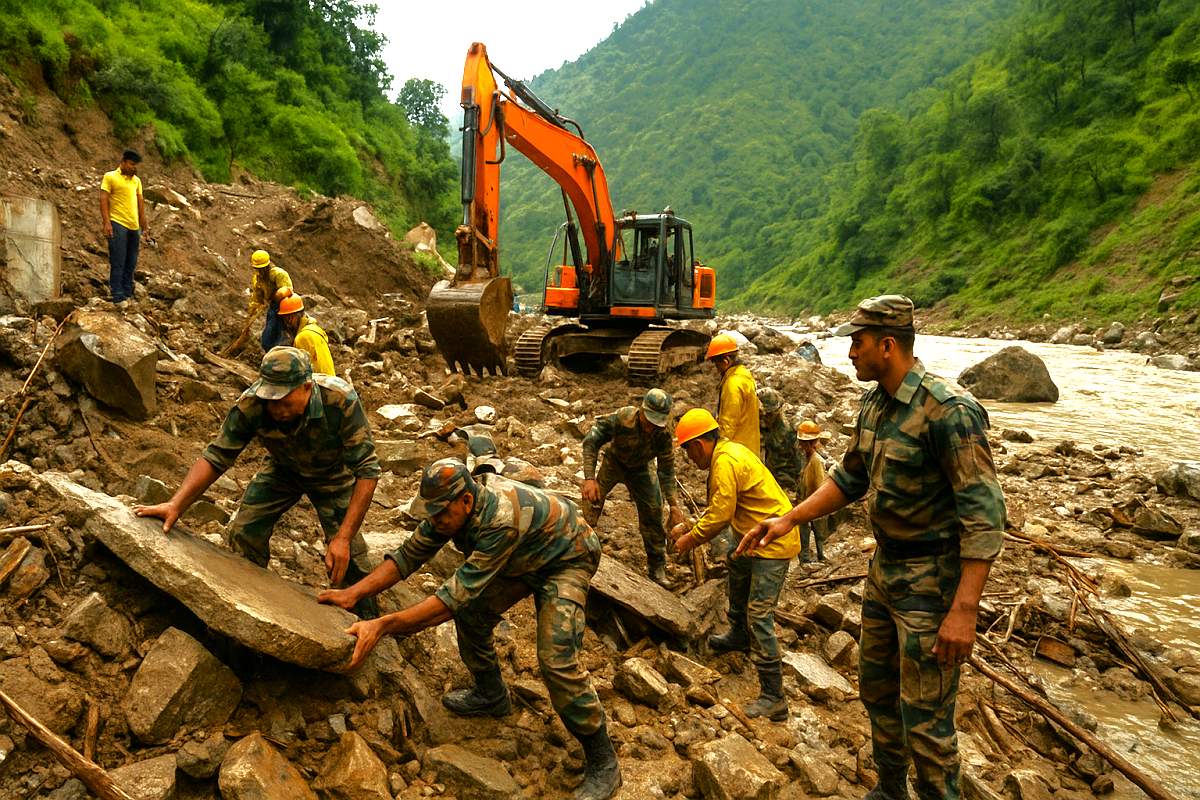On August 14, 2025, a devastating Kishtwar cloudburst struck Chositi village in Jammu and Kashmir, unleashing sudden flash floods that caused massive destruction. At least 60 people have lost their lives, more than 100 have been injured, and many remain missing as rescue teams battle adverse weather and difficult terrain to save survivors. The tragedy unfolded during the Machail Mata Yatra pilgrimage, which saw thousands of devotees gathered in the region.
Timeline of the Disaster
The cloudburst occurred at around 11:30 AM IST on August 14, 2025, when sudden, intense rainfall triggered violent flooding in the mountainous terrain of Kishtwar district. Within minutes, raging waters swept away houses, community kitchens, security posts, temples, and portions of the pilgrimage trail.
- Immediate aftermath: More than 1,200 people were reported to be in the area, including pilgrims, locals, and security personnel.
- First reports: Dozens were feared trapped under debris and floodwaters, while vehicles and makeshift structures were washed away.
- Ongoing situation: By the third day, August 16, 2025, authorities confirmed at least 60 deaths, over 100 serious injuries, and a rising number of missing persons.
Human and Infrastructure Loss
The destruction caused by the Kishtwar cloudburst is extensive:
- Houses & Buildings: At least 16 homes, three temples, and multiple government facilities were destroyed.
- Infrastructure: A 30-meter bridge and several sections of the Machail Mata Yatra path were washed away.
- Pilgrims & Locals: Over 300 people have sustained injuries, while more than 160 survivors have been rescued from flood-hit zones.
- Community Impact: Entire villages have been left without access to food, shelter, and electricity, intensifying the humanitarian crisis.
Rescue Operations
The rescue mission has been one of the largest in recent years in Jammu and Kashmir. Teams from the Indian Army, NDRF, SDRF, police, and civilian volunteers are working around the clock.
- Rescue Efforts: Specialized equipment, earthmovers, and sniffer dogs are being used to locate survivors under debris.
- Medical Response: Emergency medical camps have been set up to treat the injured, while hospitals in Kishtwar and Jammu have been placed on high alert.
- Government Support: The Prime Minister has expressed condolences and assured full support, while the Lieutenant Governor of J&K is supervising operations closely.
- Challenges: Bad weather, steep terrain, and the risk of further landslides are slowing down efforts. Helicopter evacuations are planned once weather permits.
Voices from the Ground
Survivors recall how the floodwaters arrived without warning, sweeping away everything in sight. Families have been separated, with many desperately searching for missing loved ones. Local eyewitnesses describe the scene as “unimaginable destruction” and “nature’s fury at its worst.”
Leaders across party lines have called for greater accountability in disaster preparedness, emphasizing the need for early warning systems in mountainous regions prone to cloudbursts.
Impact on Machail Mata Yatra
The annual Machail Mata Yatra, which usually sees thousands of devotees from across the country, has been suspended until further notice. The pilgrimage route has suffered massive damage, and authorities are prioritizing restoration and safety assessments before allowing future gatherings.
Climate and Environmental Concerns
The Kishtwar cloudburst is another grim reminder of how climate change is intensifying extreme weather events in the Himalayas. Rising global temperatures and changing rainfall patterns have made cloudbursts more frequent and destructive.
Experts warn that fragile mountain ecosystems and unplanned construction along pilgrimage routes increase the scale of devastation. There is growing demand for stronger climate resilience policies, early-warning systems, and better land-use planning to prevent such tragedies.
Looking Ahead
In the coming days, the focus will remain on:
- Rescue and Relief: Evacuating stranded individuals, reuniting families, and providing medical aid.
- Rebuilding: Repairing critical infrastructure, restoring the pilgrimage path, and rehabilitating displaced families.
- Preparedness: Enhancing disaster management frameworks, training local communities, and strengthening coordination between central and state agencies.
The Kishtwar cloudburst stands as a painful reminder of the vulnerabilities faced by mountain communities and the urgent need for sustainable development in ecologically fragile zones.









